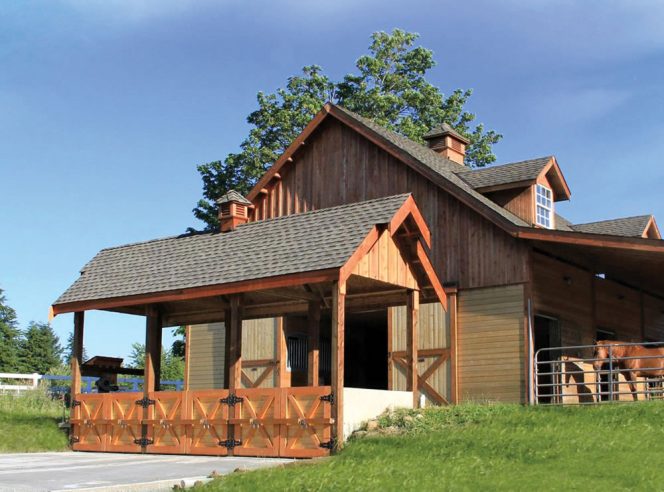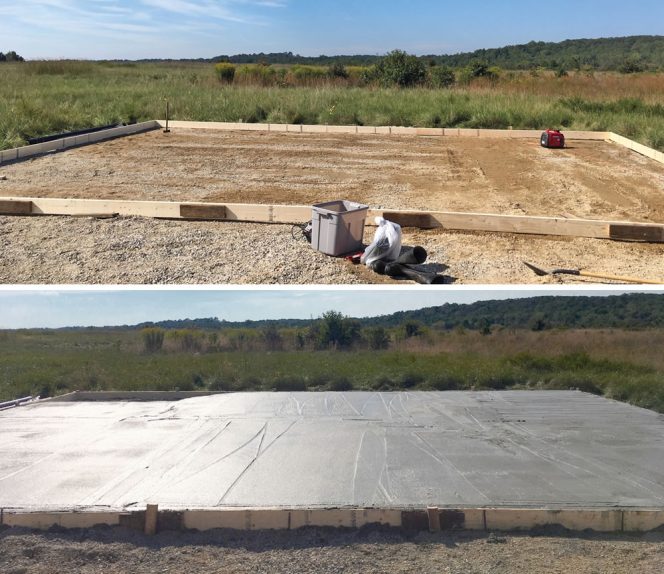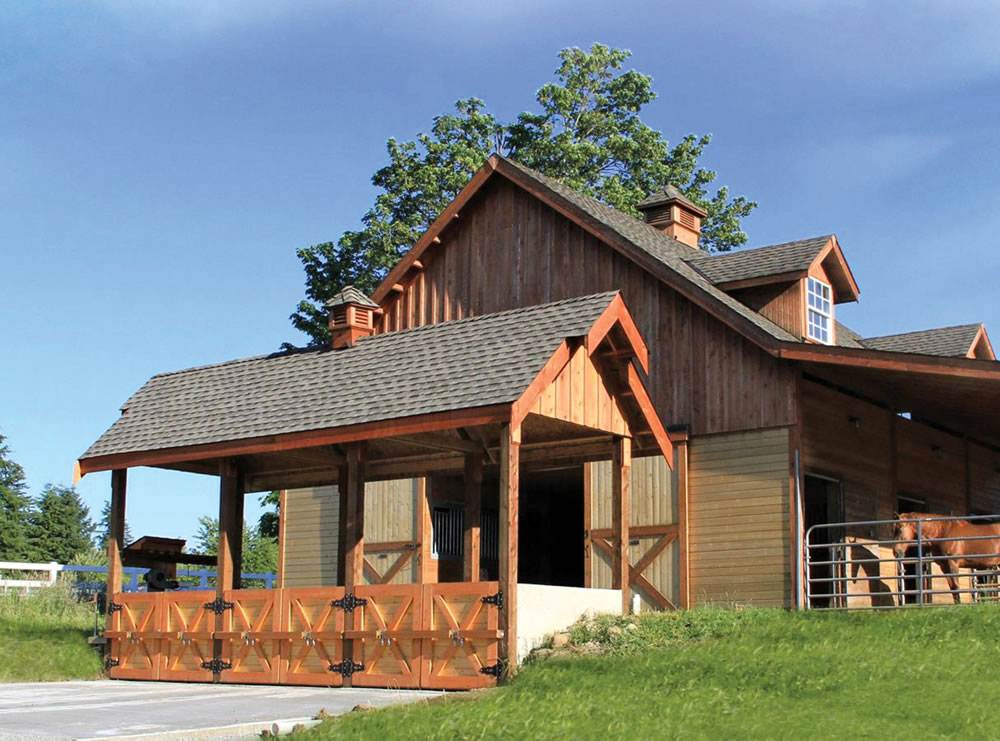New Veteran Compost site in Maryland combines public education and training with full-scale food waste composting.
Marsha W. Johnston
BioCycle October 2018

A gazebo-like composting structure, similar to the example above (in foreground), will be built at the demonstration facility. It is a medium-sized system, enclosed on four sides, designed to manage manure from 5 to 20 horses. Photo courtesy of O2Compost
“Concrete has been poured for our tipping floor, and then we will move onto building the mid-sized aerated static pile (ASP) bunker system for manure and food waste composting,” explains Justen Garrity, founder of Veteran Compost. “While we build the bunker system, we are going to use the tipping floor as a temporary composting area so that we can test out the solar powered aeration system and officially plant our flag and say ‘we are composting here’.”
Veteran Compost will occupy 5 acres of a 200-acre site that is leased from Anne Arundel County. The primary focus of the public education and training facility is manure management. “Manure is a huge problem for the Chesapeake Bay, and the state funds a couple of different technology demonstration sites,” says Garrity. “We were awarded the grant because we’re taking in manure and because of the educational component, teaching farmers and livestock owners how to keep manure out of the Bay. It’s a working educational farm equivalent for composting.”
Peter Moon, founder and president of O2Compost, which specializes primarily in on-farm and manure composting systems, received a Request for Proposal from the MDA for a manure composting system to help improve water quality in the Chesapeake Bay in December 2015. Having worked with Veteran Compost since 2013, Moon contacted Garrity to suggest putting together a demonstration site and conducting workshops for livestock owners in Maryland and surrounding states. “I’ve been teaching classes on composting for years, but this would give us a fixed location that people could go and see, where we would have a system for the two-horse folks and for the 20-horse folks,” notes Moon.
Demonstration Units
Veteran and O2Compost are building two demonstration units. First, for owners of between one and four horses or livestock equivalents, is a hand-loaded, “ASP pile-in-a-box with a quarter-horsepower blower,” explains Garrity. The small-scale wooden crate would produce between 30 and 50 cubic yards (cy) of compost per year (equal to roughly 60 to 100 cy of raw manure and bedding going into the system). Second is a medium-sized system that would handle manure from between 5 and 20 horses or equivalent. The attractive gazebo-like structure with a small cupola is enclosed on four sides. It’s wide enough for a skid loader and has swinging gates on the front that provide access to remove finished compost. This system will produce between 100 to 150 cy/year of compost (equal to roughly 200 to 300 cy of raw material). Livestock owners also can learn how to build a larger gazebo-style system that would handle manure from between 20 and 40 horses or equivalent.
A biofilter layer on top of the active composting pile is used to control odors. The layer also insulates the pile to facilitate meeting time and temperature requirements (131°F for three days) to reduce pathogens, parasites and weed seeds levels.
Public education and outreach will include formal classes and hands-on workshops, tours for students in kindergarten through college, and alliances with government agencies and nonprofit environmental organizations. The classes are free for Maryland residents as part of the grant; Moon and Garrity ran their first on-farm composting workshops in August.

Concrete has been poured for the tipping floor (before/after above). Next, Veteran Compost will build the mid-sized ASP bunker system for manure and food waste composting.
Full-Scale Composting
Veteran Compost has a composting permit and a general storm water permit from the Maryland Department of Environment (MDE) for the facility. The MDE permit limits the amount of material that can be produced to 10,000 cy/year of finished compost. “It doesn’t limit the amount of material we take in,” notes Garrity. “So, by playing around with screen size, C:N ratios, etc., there is a wide range of inbound quantities that we could take in to get to that 10,000 yards. But I estimate we will handle 20 to 30 tons/day of food waste and an equal amount of manure/bedding or wood chips each day.”
Two types of compost will be produced — wood chip and food scraps, and manure and food scraps. Composting will be done in a block bay system with 4 to 5 concrete bunkers and a 50-foot by 350-foot aerated static pile with on-grade pipes. The bunkers each hold 90 cy/batch; the extended aerated static pile can hold several thousand yards at any time, says Garrity. Combined, these systems will handle 95 percent of the material on-site — while also serving as demonstration facilities for training and public education purposes.
Veteran Compost employs a 30-day active composting phase where everything is “on air.” Next, material is screened and then cured for 60 to 90 days. “We typically flip the curing piles a few times during the curing process, and add water if needed to keep the moisture content optimized,” he explains.
All of the compost system blowers will be solar-powered to demonstrate off-grid sustainability, as the site has no electrical or water hookups. The site will also use a large number of rainwater catchment tanks to help keep storm water from becoming an issue on the site.
For the full-scale composting operation at the demonstration facility, Garrity and Moon are promoting self-hauling of manure. They are buying a trailer that will fit on a small SUV or pickup that a homeowner could use safely. “If you are a dentist with a couple of horses, and you don’t have a way to get the manure off the farm, and if you don’t want to pay to have it hauled, here’s a trailer to do it yourself,” explains Garrity.
Food waste will be delivered primarily by Veteran’s 10 collection trucks that service residential, office and light commercial organic waste generators in Washington, D.C., and strictly commercial organics generators in the Baltimore area. “The site is between D.C. and Baltimore, so we can conveniently bring material from both markets,” he adds. Veteran’s other facilities in Fairfax, Virginia and Aberdeen are each very close to capacity. “The new site allows us to put more trucks on the road. Our limitation right now is processing capacity,” notes Garrity. “We hope to be handling one truck per day by the end of October, and then 2 to 3 trucks per day in the next 60 days. We are starting some new routes in D.C. and need a place to compost all that material!”
He acknowledges that plastic and glass contamination of food waste is something Veteran is always combating, but notes that doing its own hauling provides oversight of what comes into the facilities. “Hauling is the least fun part of the business, but it allows us to control the quantity and quality of material that comes in,” he says. “I know that before our drivers load bins, they check for trash.” Veteran accepts any certified compostable paper and bioplastic items. Garrity’s experience is that films and cups “break down fine, though compostable cutlery is a challenge. But from our standpoint, it makes it easier for the customer.”
Two skid loaders have been purchased for the new facility, and Veteran plans to move its trommel screen from its Aberdeen site to Lothian. Looking ahead, Garrity says the Lothian site provides the capacity Veteran needed. “Demand for our compost outstrips our supply. We have doubled production of compost and worm castings this year and are still unable to meet demand. We believe, as do many composters around the country, that if we make a high-quality product, we will never have trouble selling the material.”
Marsha W. Johnston, an editor for Earth Steward Associates, is a Contributing Editor to BioCycle.










